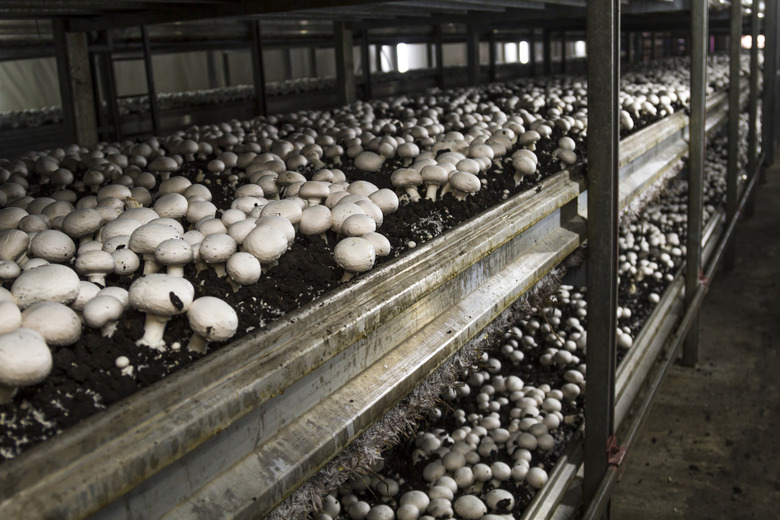How To Grow Mushrooms From Tissue Culture
Many mushrooms can be grown from a single piece of healthy tissue. When you use a tissue culture, the resulting mushrooms are an exact clone of the parent. There are three main steps to production: agar medium culture, grain spawn and fruiting on substrate.
Step 1
Potential mushroom growers can be disappointed to find a slimy, green mess where their mushrooms should have grown. The key to producing edible mushrooms instead of unwanted fungal spores or bacteria is to keep the area sterilized. To begin, sterilize the whole work area with a 10 percent bleach solution and wipe it dry. Keep windows closed to prevent contaminants from entering the area and avoid fans that will kick up the air circulation. Sterilize any hand tools you will use, such as a scalpel and inoculation loop, by holding them over a low flame, preferably suspended above it while you are working.
Agar Culture
Step 1
Agar is a specialty mix derived from seaweed. While some may enjoy producing their own agar formula, pre-made potato dextrose agar (PDA) is available at biological supply stores. Fill sterilized test tubes about one-third full with PDA. Place the tubes in a pressure cooker and bring it to 15 psi for about 25 minutes. Remove the test tubes and place them in a cradle to keep them sterile. Once the tubes are cooled, tear off a piece of the mushroom and place it so that the area you will use is facing up. Open a test tube and turn it the cap on its top, keeping the inside of the cap from touching the work area. Use your sterilized scalpel to cut a small piece of the inner tissue from the mushroom and place it in a tube. Keep the test tubes in temperatures between 55 to 70 degrees Fahrenheit and discard any tubes that start looking black or green. Mycelium, a mass of branching, threadlike filaments, will begin to grow in seven to 10 days.
Step 2
- Potential mushroom growers can be disappointed to find a slimy, green mess where their mushrooms should have grown.
- Use your sterilized scalpel to cut a small piece of the inner tissue from the mushroom and place it in a tube.
Grain Spawn
Step 1
The next step is to move your mycelium to a culture on grain. To a 12-ounce jar, add 1/3 cup of wild bird seed, 1/4 cup of water and enough cotton to fill the jar about half full, then shake it together thoroughly. You can substitute wheat, rye, millet or sorghum for the bird seed. Place lids on the jars and cook them in a pressure cooker at 15 psi for 45 minutes. Remove them from the cooker, let them cool completely, then shake them up again. Remove the caps and use a sterilized inoculation loop tool to cut mycelium from the agar. Place the mycelium sample into the grain jar, directly onto the new grain medium, and close the lid. As the mycelium begins to reproduce, shake the containers to spread it throughout the jar. Once the jar is full, it is time to move on to the final step.
Step 2
- The next step is to move your mycelium to a culture on grain.
- As the mycelium begins to reproduce, shake the containers to spread it throughout the jar.
Fruiting Substrate
Step 1
The material for the final step varies depending on the type of mushroom you are growing. The common oyster mushroom (Pleurotus ostreatus), for example, will grow on a number of media including hardwood logs and sawdust. Sterile medium may also be purchased at horticultural supply stores and is suitable for many types of mushrooms. Place the medium in any size plastic container that you wish. Even a simple milk carton with the top cut off can be lined with a plastic bag to make a simple, affordable and portable mushroom garden. After filling the containers, shake the grain bottle over the top of the substrate and use clean hands to spread it evenly over the surface. Place the container inside of a plastic bag, tie it up and place it in a dust-free location. Poke a few small holes in the bag several days later. The time for fruiting varies with each variety of mushroom.
Step 2
- The material for the final step varies depending on the type of mushroom you are growing.
- Even a simple milk carton with the top cut off can be lined with a plastic bag to make a simple, affordable and portable mushroom garden.
